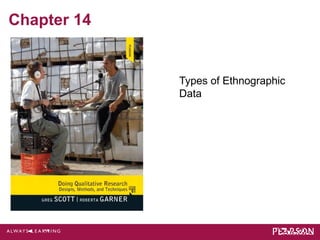More Related Content
Similar to Types of Ethnographic Data Chapter
Similar to Types of Ethnographic Data Chapter (20)
More from Beulah Heights University
More from Beulah Heights University (20)
Types of Ethnographic Data Chapter
- 2. Review: Designing Research,
Knowing The Data You Need
• Developing a research question;
• From this question deriving one or more
hypotheses you can test in the field;
• Specifying the kind of data you need in
order to test the hypotheses;
• Elucidating a methodology for
obtaining/producing these data;
© 2013 Pearson Education, Inc. All rights reserved.
- 3. Review: Designing Research,
Knowing The Data You Need
• Creating “instruments” for
recording/producing said data
– (In reference to a plan for analyzing the data);
• Collecting the data;
• Analyzing and reporting on the results of
your analysis
© 2013 Pearson Education, Inc. All rights reserved.
- 4. Types Of Data
• Behavior/Action
– Observing When Nothing Is Happening
• A capacity for orderliness and organization exists
among the observed addicts in the study
– What are people doing? How are they doing
it? When are they doing it? Where?
• And when/where/how are they not doing it?
© 2013 Pearson Education, Inc. All rights reserved.
- 5. Types Of Data
– Max Weber
– Normative uniformities
• Words
– The data you produce & results you present
depend more heavily on words than numbers
– Insider Talk
© 2013 Pearson Education, Inc. All rights reserved.
- 6. Types Of Data
• Slang represents an opportunity to learn about a
group’s behavior
• Language matters
• Nonbehavioral Data
– People’s actions and words will comprise the
bulk of the data you produce in:
• Your ethnographic research.
© 2013 Pearson Education, Inc. All rights reserved.
- 7. Types Of Data
– Environment
– Culture emanates from humans’
interconnected attempts to adapt to:
• Circumstances and conditions largely beyond their
control
• Objects and Styles
© 2013 Pearson Education, Inc. All rights reserved.
- 8. Types Of Data
– Clothing, hair styles, cosmetics, automobiles,
and the like
• Events and Rituals
– Clifford Geertz’s “Deep Play: Notes on the
Balinese Cockfight”
• The Intangibles: Norms, Values,
Standards, and Beliefs
© 2013 Pearson Education, Inc. All rights reserved.
- 9. Types Of Data
– Gathering data on norms, values, beliefs, and
standards can be challenging
– Written standards concerning individual,
group, and/or organizational activity
• People and Personas
– People constitute the heart of your
ethnography
© 2013 Pearson Education, Inc. All rights reserved.
- 10. Types Of Data
– Gathering data on norms, values, beliefs, and
standards can be challenging
– Written standards concerning individual,
group, and/or organizational activity
• People and Personas
– People constitute the heart of your
ethnography
© 2013 Pearson Education, Inc. All rights reserved.
